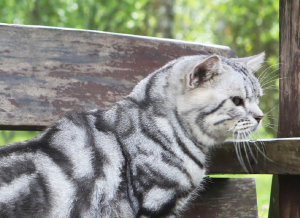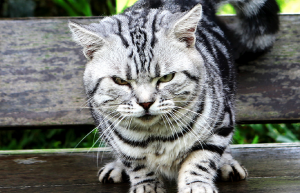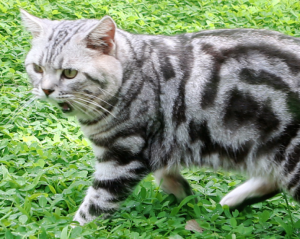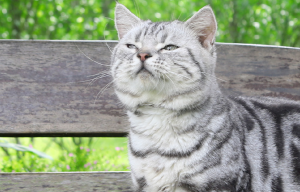Here’s the long and short of it: If you want a calm but fun, devoted but undemanding feline buddy, an American Shorthair won’t disappoint.
“[The] American Shorthair is very affectionate, friendly, and adaptable,” says Archie Uy, owner and breeder of this issue’s gorgeous cover model. It doesn’t matter if you’re living by yourself or with a big family. The American Shorthair can easily adjust to your home, whether you’re a young parent whose child is looking for a furry playmate or you’re in your sixties or seventies and craving a caring feline companion.
European-Turned-All-American

Despite its name, the American Shorthair can actually be traced back to Europeans who decided to settle in North America. While in transit, these pioneers had cats in their ships working to keep the rodent population under control.
Eventually, these hardworking cats came to be known as the North American Shorthair. No longer needed for their pest-control duties, they were loved for their demeanor and beauty.
Breeders soon took interest in these North American shorthaired cats, selecting only the best specimens to ensure that the breed retained the qualities it was loved and known for. According to The Cat Fanciers’ Association, the word “North” was dropped in 1966 and this feline finally came to be known as the American Shorthair.
Looks Good, Good Temperament

A medium-sized cat with muscular build, this gentle feline beauty boasts of lustrous fur that’s easy to maintain. The heads of American Shorthairs are longer than they are wide, with wide-set eyes that look large yet remain proportionate to their heads.
Unlike the Exotic Shorthair’s eyes, the American Shorthair’s are not as round, with the upper lid possessing an almond curve and the lower lid that of a full arc. The ears are semi-curved at the tip. This cat’s chin looks rather strong, giving its face a square shape. One look at an American Shorthair’s
face gives you the impression of cat with a sweet personality who can’t wait to make friends.
They tolerate children really well. They remain calm when playing with kids, even as these cats grow old. Known for their affectionate nature, American Shorthairs can make friends not just with humans, but with other animals, too.

They are eternally curious, wanting to explore their surroundings and play wherever they can. You may find them birdwatching at your window—enjoying a bird’s outdoor antics can provide hours of entertainment.
While some American Shorthairs may enjoy sitting and napping on your lap, others may prefer watching you fondly from a few feet away. They are friendly but do not hover, an indication of their well-adjusted personality.
Despite wanting to be among their beloved humans, they still remain selfsufficient, treasuring their freedom the same way many other felines do. Some American Shorthairs may not like being carried; they love standing and walking on all fours. So, if you want them to sit on the couch with you, call out to them instead of carrying them there—they’ll be more than happy to accommodate your request.
Considering how their feline ancestors hunted mice and rats, it should come as no surprise that the more modern American Shorthair continues to hunt small pests, such as roaches and other insects.
High on Affection, Low on Maintenance
Because of their short coats, American Shorthairs do not demand a lot of maintenance. They don’t need to be bathed frequently. Combing once a week is more than enough to ease out dead strands of fur.

Although short, their fur is usually dense and hard. These coat qualities protect them from external elements while also giving their coats that lustrous look which they are known for. The color of the coat helps to reveal its texture, with brown tabbies known to possess the best type of fur.
Yes, American Shorthairs are truly low-maintenance and do not demand a lot of your time and attention. However, they still need their playtime. Give them plenty of toys and puzzles so that they can amuse themselves while you’re busy or away.
Short Hair, Long Life
Expect an American Shorthair to live 15 years—perhaps longer, if fed the best food and given the best care.
“I give a wide range of food. I combine meat and commercial cat food. In my observation, they really love to eat raw meat. Sometimes I prepare fish, chicken or beef,” shares Uy.
They continue to grow and develop until they reach three to four years of age. Males can weigh up to 15 pounds, with females weighing a little less at 6 to 12 pounds.
The American Shorthair’s good looks and good nature are complemented by good health, something many families already smitten by this breed are grateful for. They can keep themselves occupied while the rest of the family prepares for a busy day, yet are ready to play anytime their humans want to.

It is because of their friendly disposition that American Shorthairs like to wander and explore around the house. To keep them mentally stimulated and physically fit, make sure they have enough places to discover.
“Provide enough room [for them] to play and exercise. Three to four layers of housing is ideal for them,” explains Uy. “They really like interaction with their owners and even strangers.”
Proud humans of American Shorthairs make sure their felines get the food and water they need. “Owners must also observe stool characteristic and general condition of the skin and coat.”
Annual visits to the vet may be enough to address health needs. However, be on the lookout for anything out of the ordinary. “Any changes must be addressed immediately by consulting a veterinarian,” reminds Uy.
Looking for an American Shorthair?
Remember that many cats look like American Shorthairs, a fact that many irresponsible backyard breeders take advantage of.

Although many cats may look like they belong to this breed, purebred or pedigreed American Shorthair cats have litters possessing traits typical of their breed. To ensure that American Shorthairs are bred with care and love, look for recommendations from cat clubs that espouse responsible breeding, such as the Philippine chapter of The International Cat Association (TICA Philippines).
Here are a few more things to remember for you to ensure that the American Shorthair you’re adopting is healthy, happy, and bred responsibly:
• Healthy kittens are playful and alert. “They also have expressive, round eyes,” adds Uy.
• Kittens are best adopted after three months of age. They thrive best if they stay with their mothers for the first three years of their lives – that’s where they get the best nutrition as breastfed kittens while also enjoying a few socializing lessons courtesy of their moms.

• If you’re looking for a purebred or pedigreed American Shorthair, always demand to see the papers. These include papers on pedigree, genetic tests, and vaccinations, among others. Purebred or pedigreed cats have their ancestry documented formally. Always ask for certified or original copies as it can be very easy to fake these documents. Without such documents, a cat cannot be deemed pedigreed or purebred, despite statements claiming otherwise.
• Ask about an American Shorthair’s parents. Responsible breeders have information on both the male and the female parents of American Shorthair kittens and they will be happy to tell you about them. “[Knowing about a kitten’s parents also gives you] an idea on his [traits and qualities],” explains Uy.
This appeared in Animal Scene’s April 2016 issue.






